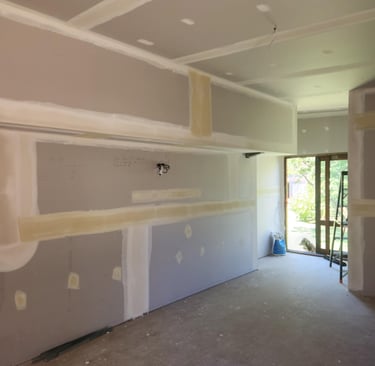Plastering Renovations
Plastering Renovations


Renovations
For most modern renovations in Geelong , plastering, also known as Gyprock or plasterboard, is the most common method. This involves attaching plasterboard to the walls and ceilings, then taping and finishing the joints to create a smooth, even surface. Drywall plastering is ideal for contemporary homes as it is quick, cost-effective, and provides a perfect canvas for painting or further decorative finishes.
For older homes in Geelong West or Newtown, you might find original lath-and-plaster walls, which require more specialized plastering techniques. If you're restoring a heritage property, traditional solid plastering may be necessary to preserve the authenticity and character of the home. Traditional plastering offers better insulation and soundproofing, and its aesthetic appeal is undeniable. It requires more skill and time but can greatly enhance the value and charm of a historic renovation.
If you’re looking to add character to your renovated home, decorative plastering could be the way to go. Features like cornices, ceiling roses, and detailed mouldings can be used to bring a touch of elegance to the space. Redbox Modds plasterers in Geelong specialize in these intricate details, allowing you to incorporate classic and contemporary styles into your home.
Proper preparation is essential for achieving a professional finish. Whether you're working on a renovation of an older house or a modern build, the preparation steps are crucial to a smooth and long-lasting plaster job.
Repairs and Surface Preparation: Before plastering can begin, any cracks, holes, or damaged areas must be repaired. This is especially important in older homes in Geelong, where walls may have settled over time or show signs of wear and tear.
Removing Old Plaster: In the case of older properties, particularly heritage homes, you may need to remove or replace old plaster. If the existing plaster is cracked or deteriorating, it may not provide a solid foundation for new plastering, and restoration or replacement may be necessary.
Damp-Proofing: Geelong’s coastal climate can introduce moisture issues, so ensure that walls and ceilings are adequately damp-proofed before plastering. Without proper damp-proofing, plaster could absorb moisture and deteriorate, leading to potential mould or mildew problems.
Insulation and Soundproofing: If you're renovating an older home, it might also be a good time to consider adding insulation or improving soundproofing while the plaster is being applied. Insulating the walls and ceilings before plastering can help with energy efficiency and noise reduction, particularly in older properties that lack modern insulation.
